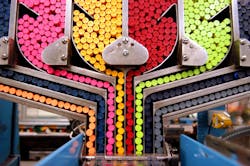At its world headquarters in Bentonville, Ark. Walmart hosted more than 500 manufacturers July 8 in order to fulfill its commitment to spending an additional $250 billion on US-made products.
“In an unprecedented event, we are opening our doors and making our buyers available to meet with suppliers with one goal in mind: buy more American products,” said Bill Simon, CEO, Walmart U.S.
The event held on July 8 is the “Made in the USA” Open Call.
“When we buy new products, suppliers hire people to make those products,” he added. “These American jobs build families and communities, and they help our country thrive. That’s really what our domestic manufacturing commitment is all about.”
Over 10 years, Walmart has said it will spend an additional $250 billion on products supporting domestic manufacturing and American jobs. To this the company will increase what it already buys of U.S. manufactured goods, will source ‘new to Walmart’ U.S. manufactured goods, and support the re-shoring of manufacturing of the goods it currently buys.
Examples of products being pitched include:
- Sleeping Bags
- Socks
- Bed Sheets
- Shower Curtains
- T-shirts
- Trash Bags
- TV Wall Mounts
- Car Adaptors for Electronics
- Office Supplies
- Plastic Toys
“By hosting the open call, we will be able to discover new products that we didn’t know were out there,” added Simon. “We’re excited to find new items that will delight our customers at prices they can afford. This is not a program or a promotion – this is economics. For many products, the math simply works.”
One of Walmart’s goals for the event is for people to leave better informed than when they arrived. To help achieve this aim, the company’s experts will host a series of educational breakout sessions on key merchandise topics, including:
- Labeling and Packaging
- Product Compliance
- Sustainability
- Supplier Administration
- The Walmart Customer
- Supplier Diversity
“Our customers have told us they want to buy products that support their communities, and with changes in energy and automation processes overseas, it is increasingly cost-effective and efficient to manufacture closest to the point of consumption ,” said Michelle Gloeckler, Walmart’s executive vice president of consumables and U.S. manufacturing.
According to data from Walmart’s suppliers, items that are made, sourced, assembled or grown in America already account for about two-thirds of what Walmart U.S. spends to buy products.
About the Author

Adrienne Selko
Senior Editor - MH&L, IW, & EHS Today
Adrienne Selko has written about many topics over the 17 years she has been with Endeavor Business Media and currently focuses on workforce development strategies. Previously Adrienne was in corporate communications at a medical manufacturing company as well as a large regional bank.
She is the author of Do I Have to Wear Garlic Around My Neck? which made the Cleveland Plain Dealer's best sellers list. She is a senior editor at Material Handling & Logistics, EHS Today, and IndustryWeek.
Editorial Mission Statement:
Manufacturing is the enviable position of creating products, processes, and policies that solve the world’s problems. When the industry stepped up to manufacture what was necessary to combat the pandemic, it revealed its true nature. My goal is to showcase the sector’s ability to address a broad range of workforce issues including technology, training, diversity & inclusion, with a goal of enticing future generations to join this amazing sector.
Why I Find Manufacturing Interesting:
On my first day working for a company that made medical equipment such as MRIs, I toured the plant floor. On every wall was a photo of a person, mostly children. I asked my supervisor why this was the case and he said that the work we do at this company has saved these people’s lives. “We never forget how important our work is and everyone’s contribution to that.” From that moment on I was hooked on manufacturing.
I have talked with many people in this field who have transformed their own career development to assist others. For example, companies are hiring those with disabilities, those previously incarcerated, and other talent pools that have been underutilized. I have talked with leaders who have brought out the best in their workforce, as well as employees doing their best work while doing good for the world.
